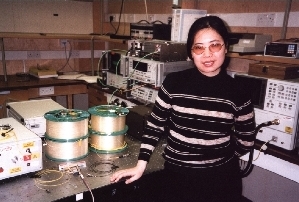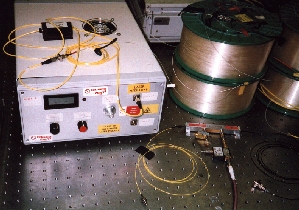


Dr Lucia Hu at British Telecom.
The sensitivity of a radio telescope or array determines the faintest objects that can be observed by it and it is hoped that during the first decade of the next century MERLIN will be upgraded to achieve a sensitivity at least ten times better than at present allowing it to open up spectacular new observational possibilities in both galactic and extragalactic astronomy including the ability to detect the thermally generated emission from almost all the stars visible to the naked eye.
In the past it has been possible to make substantial improvements in MERLIN's sensitivity by improving the low noise receivers on each telescope which amplify the ultra-weak signals reaching us from remote radio sources. Current systems, using special transistor amplifiers cooled to around 12K are nearing the theoretical limits of performance so the potential for further sensitivity improvements is limited. We thus have to look elsewhere to make major gains.
Apart from the expensive option of building very large radio telescopes the only other possible avenue is to increase the bandwidth of the received signals thus collecting more energy from the radio sources we observe. The microwave radio links now used can carry two bands of 15 MHz, one for each hand of polarization, and there is no way of significantly increasing their capacity. Funded by a PIPSS grant from PPARC, Jodrell Bank staff are therefore carrying out a collaborative project with British Telecom to investigate the feasibility of relaying very broad band signals over fibre optic cables.
The sensitivity of radio telescopes increases as the square root of the bandwidth so that if, for example, the bandwidth could be increased to 1000 MHz per channel then the sensitivity would be improved by a factor of 8. This, allied to improvements in the receivers and elsewhere, could achieve the overall ten-fold increase in sensitivity desired for the upgraded array.
There are two major problems in sending very broad bandwidth signals over long distance fibre optic cables. The first is the requirement for suitable optical amplifiers to boost the signals along the route. This can now be achieved by using Erbium Doped Fibre Amplifiers, in which the signal is boosted as it passes through a special length of fibre as a result of optically pumped LASER amplification. The second is the problem of dispersion in the glass. The different wavelengths of the light needed to carry the broad band of signals travel at very slightly different speeds along the fibre so taking differing times to traverse the optical fibre link. In future new types of fibre designed to have zero dispersion at the wavelengths where the broad band amplifiers can operate will be laid across the country but with currently installed cable suitable compensation must be provided as part of the system. Again modern technology has produced a simple solution in the form of a Bragg Reflection grating in which the faster travelling signals are made to travel a longer distance thus bringing the different parts of the band back into precise synchronisation. One such grating is needed for every 75km of cable and short lengths of special de-dispersion cable are used to provide the final compensation for each optical fibre link.

Light Wave Analyser used for the fibre link experiments.
Dr Lucia Hu, funded by the PIPPs grant, is testing links of up to 200km in length at the British Telecom Research Laboratories at Martlesham supported by their own research staff. She has shown that, using these techniques, it appears feasible to transfer two bands of 1000 MHz signals over distances of 100 to 200 km with sufficient signal to noise ratio. Future work, both at British Telecom and at Jodrell Bank, will investigate further aspects of the fibre optic links.
The expectation is that, by the conclusion of the grant, a proven technique will be available which will allow us to design an instrument with superb and exciting capabilities, MERLIN3.

|
Return to the Jodrell Bank Home page |